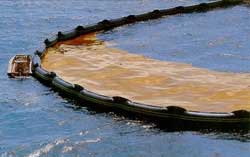 Image via WikipediaBy Travis Zdrazil
Image via WikipediaBy Travis ZdrazilIf you've watched the news during the Gulf of Mexico Oil Spill Disaster, you've seen plenty of them in action: Oil containment booms, lined up along coast lines to prevent the oil from contaminating the shore.
Here's why they were the logical choice for the task. The problem with oil spills, especially if they happen on or near water, is that they spread quickly and can get out of control rapidly. And oil containment booms can often stop their spread completely, or at least slow it down.
Oil booms actually come in two varieties - absorbent and non-absorbent. The absorbent booms are especially handy because not only can they contain oil spills but they can also clean them up. They are also referred to as oil spill booms, sorbent booms, marina booms, marine booms, ocean booms or sea booms. In spite of their name, they can also be used on land to clean up large amounts of oil. And not just oil either, but any other kind of hydrocarbons as well, including gasoline, motor oil, jet fuel, hydraulic oil, and kerosene. However, they cannot be used for water based chemicals, acids, or aggressive chemicals of any kind.
Oil containment booms are designed to float on the surface of water. They're long sausage-shaped mesh casings stuffed with oil only absorbent polypropylene filler. This makes them float on water whether or not they're already full. They also have nylon ropes and a durable linking system, so they can be linked together - and more easily retrieved when they're full. Because they are floating right on top of the water, where any of the spilled oil will be as well, they form a barrier and are highly effective in preventing any oil from getting away.
Their bright white in color serves an important function as well. When they have absorbed all the oil they can take, they plump up - which makes them easier to see. This in turn is a hard-to-miss indicator of when they need to be replaced. After all, they're costly, so you don't want to replace them when they still have capacity left.
They're perfectly suited for use on any kind of body of water, whether that's a lake, a river, a marina, or even the open ocean. Of course, after the Gulf of Mexico oil spill we've seen a lot of oil containment booms in action - on TV and in other news media - and even people who had never heard or thought about them have become familiar with their sight and use.
Want to know more about oil containment booms? Get valuable tips and the latest news about absorbents and other environmental safety products on Travis Zdrazil's Safety Maintenance News blog and get his free newsletter too. Travis is an expert on environmental safety products and has supplied businesses with products to aid in meeting EPA and OSHA requirements for more than 10 years.
You may publish this article, but must keep the resource box ©2009 PCI Products Company. All rights reserved.
Article Source: http://EzineArticles.com/?expert=Travis_Zdrazil
http://EzineArticles.com/?Oil-Containment-Booms---As-Seen-on-TV---Keep-Oil-Spills-From-Spreading-Out-of-Control&id=4936335

You've seen a lot of them on TV lately -- oil booms played a crucial part in managing and cleaning up the Gulf of Mexico oil spill.
ReplyDeleteSome problems with oil booms are they are not fool proof. They work decently on calm weathers. They do not prevent the ocean waves from carrying over the top of the boom.